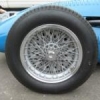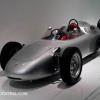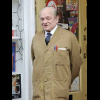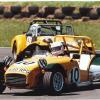Merely entitling that book the 'Autocourse History of the Grand Prix car 1945-65' was due to the conscious thought that what amounted to significant Grand Prix racing in 1946-47 should not be described as "Formula 1" (or "One"), and that pinnacle-level Grand Prix racing 1952-53 was conducted to Formula 2 regulations, and not Formula 1. Furthermore the book sought to trace the stabilisation of significant "open-wheeler" Grand Prix racing 1945-49 before the FIA's Drivers World Championship was launched in 1950 - in part as a catch-up measure to match the previous year's introduction of the FIM World Championship.
Twenty-plus years ago TNF trawled this matter quite thoroughly, with Vitesse2 posting this useful overview of interesting and relevant references - which I hope he won't mind my reproducing here. These are his words, not mine:
"This is a collection of extracts from books and journals which we have gathered ("we" being Hans, Marc, Alessandro, Tony Kaye, Frank (FEV) and myself). As you will see, we have moved on significantly since the thread ended ... Perhaps we can impose on a few of you to consult your own libraries and tell us what you find? Especially interesting would be anything from original magazine sources, from any country.
Red text is considered dubious or is just plain wrong! Names in brackets are contributors, and there are a few appended comments - the original quotes are, I hope, obvious.
1945 [Alan Henry: Autocourse 50 Years of World Championship Grand Prix Motor Racing, 2000, pg.27] Before the war, a change in Formula A regulations –effectively F1- had been penciled in for 1941, These rules would call for 4.5-litre unsupercharged or 1.5-litre supercharged engines, and in 1945 the newly titled Fédération Internationale de l’Automobile (FIA) quickly adopted these regulations for those who felt able to take part. Red text makes a wrong statement, compared to L’equipe of June 22, 1946. (Alessandro Silva)
1946 Feb ***ORIGINAL SOURCE [Das Auto, 1948, No. 2, pg. 16] …1938-1946..In the year 1938 a new formula was introduced….. Theoretically, this formula was in place since it was not terminated by decision of the appropriate authority until February 28, 1946, the day of the first postwar meeting of the AIACR. (Hans Etzrodt)
1946 Feb [Laurence Pomeroy: The Grand Prix Car, Vol. Two, 1949, 1954, pg. 24] When Formula I was agreed at a meeting of the Federatiom Internationale de l’Automobile on February 28th, 1946, it was intended that it should cover the years 1947, 1948, 1949, 1950 and 1951. In October, 1951, the F.I.A. decided to extend the life of Formula I up to the end of December, 1953, that is to say, by a further two years. …..(Hans Etzrodt)
1946 Mar ***ORIGINAL SOURCE [The Motor, March 27, 1946, p161] ... Now, for 1947 and 1948 there is a nice new Formula, which turns out to be what we had all hoped - up to 1500cc supercharged and up to 3-litres un-supercharged.
So, when was the formula changed back?? And why?? And by whom?? (Richard Armstrong)
1946 May ***ORIGINAL SOURCE [Motor Sport, May 1946, p105] New Formula
The AIACR has met again and provisionally decided on a formula for the classic races of 1947-51 with which few people will wish to quibble. No impositions will exist, beyond a capacity limit of 1.5 litres for supercharged engines and 3 litres for un-supercharged engines. Special fuel is to be permitted. This is the picture at present and it looks very satisfactory. But confirmation is to follow, at another AIACR meeting next month.. A change seems unlikely, however (Richard Armstrong)
1946 Jun ***ORIGINAL SOURCE [L’equipe, June 22, 1946] CSI a fixé hier à Paris la formule internationale. CSI has fixed yesterday (June 21, 1946) in Paris the international formula. 1.5 L s/c & 4.5 u/s. free fuel. No other provisions except: two rearview mirrors and two seats maximum. (Alessandro Silva)
1946 [Adriano Cimarosti: The Complete history of Grand Prix Motor Racing, 1986, pg. 130] At the end of 1946 the newly formed Fédération Internationael de l’Automobile decided to establish new rules for Grand Prix racing, and for the first time the term “Formula One” was applied. The rules laid down maximum capacities of 1500cc for supercharged engines and 4500cc for unsupercharged engines, which represented a change in the ratio between supercharged and unsupercharged engines from 1:1.5 (or 3 litres to 4.5 litres) which had existed since 1938, 10 1:3. (Hans Etzrodt)
1946 [Rodney Walkerley: Motor Racing, Facts & Figures, 1961, pg.86] 1946 No Formula was announced by the re-titled Federation Internationale de L'Automobile (FIA) and events were run for whatever cars existed, mostly 1500cc and 4½ litres un-supercharged. (Richard Armstrong)
1947 [Henri Cohin L’Historique de la Course Automobile, 1894-1976 Editions Fanauto, 1977, page 289] A new formula applicable from 1947 until the end of 1953 is installed: the Formula1 will be limited to 4500cc for unsupercharged cars or 1500cc for supercharged. (Frank Verplanken)
1947 Oct [Doug Nye: Auto Course History of the Grand Prix Car 1945-65, 1993, pg. 33] On 23 October 1947, the doors of the Grand Palais in the Champs Elysées, Paris, opened on the second post-war Salon de l’Automobile exhibition.…. …. During the Salon the FIA’s sporting commission met to review motor racing’s future. They reached several important decisions.
Above all they confirmed that the existing fait accompli of 1.5 litres supercharged and 4.5 litres unsupercharged classes should apply for Grand Prix racing ostensibly until the end of 1953, six more full seasons. However, from 1 January 1948 any type of fuel would be permitted in place of the alcohol-only restrictions applied perforce since the resumption of serious competition in 1946. In addition, the meeting agreed to adopt a new Voiturette Formula for unsupercharged cars of no more than 2000 cc capacity and supercharged cars of no more than 500 cc.
To differentiate these two International single-seater Formulae, the Grand Prix class was referred to initially as Formula ‘A’, the Voiturette class as Formula ‘B’. To us and to the public at large they were to become better known, respectively, as ‘Formula 1’ and ‘Formula 2”. (Hans Etzrodt)
1947 Nov ***ORIGINAL SOURCE [Das Auto, 1947, No. 11, pg. 16] …..The meeting of the FIA brought a sensation in its decisions by the sporting commission. ...As of January 1, 1948, a second racing formula will take effect….. cars with compressor up to 500 ccm, cars without compressor up to 2000 ccm; minimum distance 200 km. (Hans Etz)
1947 Dec ***ORIGINAL SOURCE [Motor Sport December 1947 p376] Formula Racing
It seems that the existing Formula will govern International racing until 1953, with the alteration that from next year cars can be run on any fuel the entrant desires to use. For new boys, this means up to 1.5 litres supercharged, and up to 4.5 litres unblown. A most interesting voiturette Formula is also to be put into operation, confining small-car races to blown cars up to 500cc, and unblown cars up to 2 litres. This is a most intriguing development, if a nasty swipe to purveyors of British supercharged eleven-hundreds, such as the K3 MG.
Both before and after WW2, Motor Sport refer exclusively to "Formula racing" and "Formula cars" - I saw no references to Formula A or B (or Formula 1 or 2) up to the end of 1948. The first reference to the FIA (rather than the AIACR), which I have found is in March 1948. (Richard Armstrong)
1947 [G.N. Georgano – Editor –: The Encyclopaedia of Motor Sport, 1971, Dennis Jenkinson: pg.19] In 1947 the A.I.A.C.R. was reconstituted and renamed Fédération Internationale de l’Automobile or FIA for short, and the international subcommittee or Commission Sportive Internationale (CSI) controlled the racing rules and drew up the various classes of racing to be held at international level. Red text is a wrong statement, compared to L’equipe of July, 1946. (Alessandro Silva, Nov. 1, 2001)
The principal interest of the CSI was Grand Prix racing, regarded as the premier category, and sports car racing and other events were left to national clubs, but in 1947 it was apparently that the sport was growing rapidly and something more than grand Prix racing was going to be needed internationally. Racing was therefore divided into groups or formulas.
Grand Prix category was known as Formula 1, the Voiturette category became Formula 2 and 500 cc racing in Great Britain was called Formula 3. Red text: there was no Formula 1 yet in 1947 (Hans Etzrodt).
1947 [Rodney Walkerley: Motor Racing, Facts & Figures, 1961, pg.88] 1947 The CSI of the FIA announced the new Grand Prix regulations for the period 1948-1953, intended to include the pre-war cars. Two Formulae were drawn up - Formula I, for supercharged cars with a cylinder volume of up to 1,500 cc, and un-supercharged up to 4½-litres, which, it was thought, would equalize the performances that had been so widely separated under the pre-war rules of 3-litres with supercharger and 4½-litres un-supercharged. There were no limitations as to weight, fuel or type of body, apart from the obligation to fit two full-sized rear mirrors. Red text makes a wrong statement, compared to L’equipe of June 22, 1946. (Alessandro Silva, Nov. 1, 2001)
1947 [Giuseppe Guzzardi & Enzo Rizzo: The Century of MOTOR RACING, pg. 66, 1999] A number of early post-was events are worthy of particular mention including the formation of the FIA ( Fédération Internationale de l’Automobile), still responsible for all international motor racing events of European origins. The FIA took it upon itself to recognize the regulations for GP type racing within the context of a technological panorama in need of reconstruction and generally restricted economic resources. Thus was Formula 1 born in 1947 with its initial format dictated by the availability of cars developed before the war… (Hans Etzrodt)
1947 [David Hodges: A-Z of Formula Racing Cars, 1990, pg. 272]
When racing picked up after the Second World War grids were made up of late-1930s cars, and formule libre rules were applied so that the organizers of events could at least get fields together. By 1947, however, there was sufficient confidence for the Formula A that had been framed for 1941 to be promulgated as Formula 1. (Richard Armstrong)
1948 Feb ***ORIGINAL SOURCE [Motor Sport, February 1948, pg. 39] The FIA surprised a lot of people by announcing an additional Formula for 1948 Grand Prix racing..........FormulaI, and Formula II being for super-charged cars up to 500cc and unsupercharged cars up to 2000cc." Motorsport. The first I came across was in the February issue p.39. It would appear from this that FIA used the terms F I and F II. There is no mention of either F 1 or F 2, but there are other references to F I and F II in the same article. The next reference I found was not until the June edition when the GP de Roussillon was described as "for Formula II cars....". (Tony Kaye).
1948 Jul ***ORIGINAL SOURCE [Speed Age 1948 July, p 21] ".....the Grand Prix of Pau......open to the Formula I cars....." The writer of this was none other than Count Lurani..... (Tony Kaye).
1948 Nov ***ORIGINAL SOURCE [Motor Sport, November 1948, pg. 467] Despite all the races and race reports in the magazine during the summer months, the next reference I found was not until the November edition (p.467). Circuit of Florence. "This Formula B race was won by......" Now that's a surprise, F B not F II!
And that's it for the whole of 1948. But it really isn't so surprising that there should be so few references to the Formula as variously A, B, 1, 2, I or II. They simply referred to the events as Grands Prix or the cars as Grand Prix cars. (Tony Kaye).
1948 [D. S. Jenkinson: Motor Sport Racing Car Review 1949, p 105, published 1948] Despite its title, Denis Jenkinson's book "Motor Sport Racing Car Review 1949" was written in 1948 and is about the 1948 season. Throughout he refers to Formula A and Formula B. For instance on page 105 he states: As this small car racing was proving so popular, the International governing body of motor racing, the F.I.A., formerly the A.I.A.C.R., drew up two Formulae for International racing for 1948. Formula A was for the existing Grand Prix cars and Formula B for the small cars... My take on this subject is that in the very early days the formulae were usually referred to by letter or by Roman numeral and hardly ever as F 1 and F 2. (Tony Kaye).
1948 [John Eason Gibson: Motor Racing 1947, page 89, published 1949] The following are the current regulations governing Racing Cars including the 1948-1953 International formulae and Sports Cars as defined in the International Sporting Code.
RACING CARS
Formula 1, (F.I. 1)………….
Formula 2, (F.I. 2)………….
This was published in 1949 when the term Formula 1 became more popular (Hans Etzrodt).
1948 [Rex Hayes: The Vanishing Litres, 1957, pg. 147] In 1948 two Grand Prix Formulae were accepted for the following year. The major formula, which henceforward was to be known as Formula 1 (sometimes A), was as before, namely, 1,500 c.c. supercharged or 4.5 litres unsupercharged. The upgrading of what was formerly the Voiturette class and in the future to be known as Formula 2 (sometimes B) was for cars of 2 litres unsupercharged or 500 c.c. supercharged. ……(Richard Armstrong)
1948 [Anthony Pritchard: A Century of GRAND PRIX Motor Racing, 1998 compiled by A. Pritchard, pg. 73] 1946-48 Motor racing resumed after the war with a Formula Libre (’free formula’) race held in the Bois de Boulogne in Paris. Initially the official formula was a continuation of the pre-war Formula A for cars of 3 litres supercharged and 4.5 litres unsupercharged. There was a minimum race distance of 500 kilometers (311 miles). In reality the races were contested by a rather mixed bag of pre-war Voiturettes (the 1500 cc supercharged equivalent of modern Formula 2), 3-to 4.5-litre unsupercharged cars (French Delage, Delahaye and Talbot) and the old 8C-308 3-litre supercharged Alfa Romeo. From 1947 there was a new formula, soon to be called Formula 1, but originally again known as Formula A, for cars of 1500 cc supercharged and 4500 cc unsupercharged. The minimum race distance remained unchanged. “Pre-war Formula A” was never heard before! (Hans Etzrodt)
1948 [Pablo Gimeno Valledor: The International Penya Rhin Grand Prix, 1997, page 152]
In 1948 the Formula A and the Formula B were defined. In many fine books they mistakenly talked about Formula 1 and Formula 2, terms which were not used until 1950…..
The subsequent F1 and F2 of 1950, which were in force until 1953, were exactly the same as the Formula A and B, only the name changed…… (Hans Etzrodt)
1948 [Laurence Pomeroy and Rodney Walkerley: The Motor Year Book 1949, p 37, 53, published April 1949] Racing Results of 1948 Formula B Races. Term used instead of Formula 2, (Hans Etzrodt)
International Sporting Calendar for 1949 The suffix “A” or “B” in brackets indicates that the event concerned is to be run under the International Grand Prix Formula A (1½-litres supercharged, 4½-litres unsupercharged) or Formula B (500 c.c. supercharged, 2-litres unsupercharged). (Hans Etzrodt)
1948 Karl Ludvigsen: Classic Grand Prix Cars, 2000, pg. 109] …..The choice of the CSI was indeed a formula for Grand Prix cars of 1½ litres supercharged and 4½ normally aspirated. Although it wasn’t officially in effect until 1948, the new formula was adopted earlier by the organizers of major Grand Prix events.
At the time consideration was given to a new secondary or Voiturette formula. This was eventually settled at 2 litres unblown. Initially, the two categories were distinguished as Formula A and B, but the usage of Formulas 1 and 2 was soon adopted. Thus by the end of the forties the term ‘Formula 1’ for Grand Prix racing was both established and accepted. (Hans Etzrodt)
1949 Jul ***ORIGINAL SOURCE [Das Auto, July 1949, No. 16, No. 17, No. 18] In issue #16, racing report of Reims, July 1949, both, Formel 1 and Formel 2 is written. Issue #17 writes about the Bari race Formel 2. In the report of issue #18, pg. 20, about the Lausanne race in August 1949, written by Paul Pietsch, it is typed Formel I and II instead of 1 and 2. (Hans Etzrodt)
1949 [Laurence Pomeroy and Rodney Walkerley: The Motor Year Book 1950, p 179, published March 1950] Racing Results of 1949
Formula A. Formula A events admit cars up to 1,500 c.c. supercharged and up to 4½-litres unsupercharged.
Formula B Racing. Formula B admits cars up to 500 c.c. supercharged and 2 litres unsupercharged. (Hans Etz.)
1949 [David Venables: First Among Champions: The Alfa Romeo Grand Prix Cars, 2000, pg. 250] [regarding Brivio] ..and may be regarded as the father of the World Championship, as he made the initial proposal to the FIA in 1949. I had already seen this story (I forgot where) to the effect that Lurani and Brivio, brotherly friends, had discussed the matter between them and Lurani, who was on the FIM (Motorcycle Federation) board, had it passed first, in 1948. If confirmed, it would make Brivio one of the outstanding figures in motoring history! (Alessandro Silva)
1950 [Rodney Walkerley: Motor Racing, Facts & Figures, pg. 98] 1950 A new circuit, especially constructed, was opened in a natural amphitheatre at Brands Hatch, 20 miles south-east of London, for 500 c.c. racing. This branch of the sport, established in Britain soon after the war as a form of inexpensive racing, was now at a stage, which warranted its definition by the F.I.A. as an International Formula III. …
The International Calendar was now overcrowded with events for Formula I, II and III, and ... (Hans Etzrodt)
FIA Under the title F1 Q & A, I (Hans.E.) found the following information (supplied by FIA) at the Forix site:
History QUESTION: How far back does Formula One go?
ANSWER: …Following the introduction of the first "formula" in 1904 by the FIA (which restricted maximum weight), categories were created for the smaller cars, but the name "FormulaOne" did not appear until 1948. The first Formula One race was at Pau on 29 March 1948 and was won by a Maserati. The FIA Formula One World Championship was created in 1950, and the first Formula One World Championship race was the British Grand Prix, at Silverstone on 13 May 1950. (Hans Etzrodt)"
DCN






















